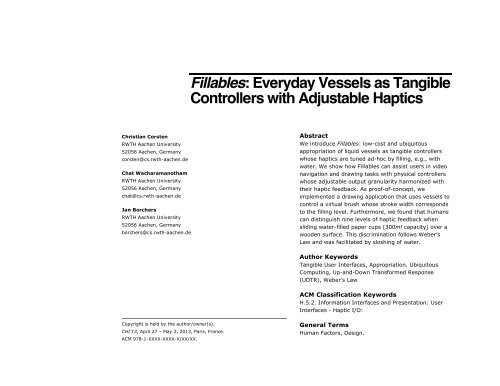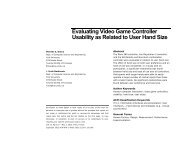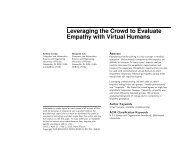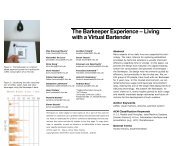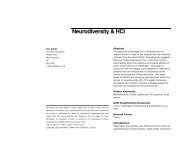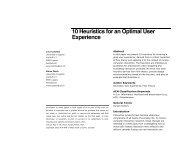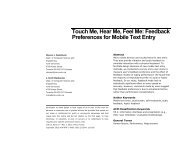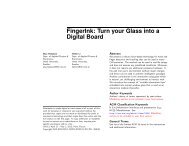Fillables: Everyday Vessels as Tangible Controllers ... - alt.chi 2013
Fillables: Everyday Vessels as Tangible Controllers ... - alt.chi 2013
Fillables: Everyday Vessels as Tangible Controllers ... - alt.chi 2013
Create successful ePaper yourself
Turn your PDF publications into a flip-book with our unique Google optimized e-Paper software.
Christian Corsten<br />
RWTH Aachen University<br />
52056 Aachen, Germany<br />
corsten@cs.rwth-aachen.de<br />
Chat Wacharamanotham<br />
RWTH Aachen University<br />
52056 Aachen, Germany<br />
chat@cs.rwth-aachen.de<br />
Jan Borchers<br />
RWTH Aachen University<br />
52056 Aachen, Germany<br />
borchers@cs.rwth-aachen.de<br />
Copyright is held by the author/owner(s).<br />
CHI’13, April 27 – May 2, <strong>2013</strong>, Paris, France.<br />
ACM 978-1-XXXX-XXXX-X/XX/XX.<br />
<strong>Fillables</strong>: <strong>Everyday</strong> <strong>Vessels</strong> <strong>as</strong> <strong>Tangible</strong><br />
<strong>Controllers</strong> with Adjustable Haptics<br />
Abstract<br />
We introduce <strong>Fillables</strong>: low-cost and ubiquitous<br />
appropriation of liquid vessels <strong>as</strong> tangible controllers<br />
whose haptics are tuned ad-hoc by filling, e.g., with<br />
water. We show how <strong>Fillables</strong> can <strong>as</strong>sist users in video<br />
navigation and drawing t<strong>as</strong>ks with physical controllers<br />
whose adjustable output granularity harmonized with<br />
their haptic feedback. As proof-of-concept, we<br />
implemented a drawing application that uses vessels to<br />
control a virtual brush whose stroke width corresponds<br />
to the filling level. Furthermore, we found that humans<br />
can distinguish nine levels of haptic feedback when<br />
sliding water-filled paper cups (300ml capacity) over a<br />
wooden surface. This discrimination follows Weber’s<br />
Law and w<strong>as</strong> facilitated by sloshing of water.<br />
Author Keywords<br />
<strong>Tangible</strong> User Interfaces, Appropriation, Ubiquitous<br />
Computing, Up-and-Down Transformed Response<br />
(UDTR), Weber’s Law<br />
ACM Cl<strong>as</strong>sification Keywords<br />
H.5.2. Information Interfaces and Presentation: User<br />
Interfaces - Haptic I/O:<br />
General Terms<br />
Human Factors, Design.
Fine granularity:<br />
1 frame per sliding distance<br />
Initial video position<br />
00:00.1<br />
Medium granularity:<br />
1 second per sliding distance<br />
Coarse granularity:<br />
10 seconds per sliding distance<br />
00:00.2 00:02.1 00:10.1<br />
(a) (b) (c)<br />
d F<br />
N<br />
= 2N<br />
d F<br />
N<br />
= 1N<br />
d<br />
F N = 0.1N<br />
Figure 1. A drinking vessel (“Fillable”) mimics a virtual slider knob to scroll through a video at different<br />
granularities b<strong>as</strong>ed on the water level. The same sliding distance d navigates the video in (a) one-frame,<br />
(b) one-second, and (c) ten-seconds increments. A full vessel is heavier and can be slid with more<br />
precision than an empty (lightweight) one. Since the user can feel these differences when sliding the<br />
vessel on the table, <strong>Fillables</strong> make virtual granularity tactile. Weight of a vessel is illustrated by its<br />
normal force (FN).<br />
Introduction<br />
Media professionals frequently use dedicated physical<br />
controllers for t<strong>as</strong>ks that require many levels of<br />
precision, many repetitions, higher degrees of freedom,<br />
or concurrent inputs. An apt example is the Shuttle jog<br />
knob (Fig. 2), which allows a cutter to navigate a video<br />
at different granularities, e.g., in ten frames per step or<br />
frame-by-frame.<br />
However, such special controllers are not at everyone’s<br />
disposal due to their cost and limited applicability.<br />
Consequently, this leaves the amateur to rely on cl<strong>as</strong>sic<br />
mouse and keyboard input, which may be less efficient,<br />
e.g., when multiple tangible controllers would be a<br />
better fit for the t<strong>as</strong>k.<br />
Research h<strong>as</strong> addressed this issue by letting users<br />
repurpose objects at hand <strong>as</strong> temporary controllers<br />
[2,7]. However, such tangibles are static in their haptic<br />
nature. Therefore, we propose <strong>Fillables</strong>: adjustable<br />
tangibles that let users (1) control the haptic feel and<br />
(2) adjust the transfer function (e.g., scrolling<br />
granularity) between the controller and its output.<br />
<strong>Everyday</strong> vessels are used to physically instantiate<br />
controllers, such <strong>as</strong> sliders or jog knobs. By filling<br />
them, e.g., with water, the user can tune these<br />
tangibles to satisfy both (1) and (2).<br />
For example, an empty vessel can be slid to mimic<br />
coarse time-b<strong>as</strong>ed video navigation (Fig. 1). After filling<br />
the vessel, it is heavier, hence harder to push.<br />
Consequently, the vessel is (1) less susceptible to<br />
accidental knocks and (2) feels different in control,<br />
therefore conveying a change in the transfer function to<br />
the user via the haptic channel. This way, <strong>Fillables</strong> let
Physical buttons can be<br />
used to create<br />
shortcuts, e.g., to set a<br />
cut mark.<br />
Figure 2. ShuttleXpress<br />
jog knob. Turning the<br />
jog wheel in the middle<br />
navigates a video frame<br />
by frame. The ring<br />
around the knob<br />
controls the video at<br />
different granularities.<br />
Turn the ring around<br />
the knob up to 45°<br />
clockwise (counterclockwise)<br />
to navigate<br />
at different granularity.<br />
The more the knob is<br />
turned, the f<strong>as</strong>ter the<br />
video is forwarded<br />
(rewinded). This speed<br />
is maintained <strong>as</strong> long<br />
<strong>as</strong> the user holds the<br />
ring at that position.<br />
The ring automatically<br />
flips back when it is<br />
rele<strong>as</strong>ed.<br />
Turn the inner knob<br />
clockwise (counterclockwise)<br />
to navigate<br />
forward (backward)<br />
frame by frame.<br />
Detents indicate when<br />
the next frame is<br />
reached (10 detents<br />
per whole turn).<br />
users create multiple physical controllers<br />
that are individually adjustable by filling<br />
to make haptics correspond to the<br />
granularity of the tool – in short: <strong>Fillables</strong><br />
make granularity tactile.<br />
This work gives first insight into the<br />
vision of <strong>Fillables</strong>. The contributions are:<br />
(1) the concept of <strong>Fillables</strong>: tangibles<br />
made of vessels with adjustable haptics<br />
through filling, (2) interaction design for<br />
tactile granularity including a protptype,<br />
and (3) a preliminary study exploring the<br />
human ability to discriminate varied<br />
<strong>Fillables</strong> of different tactile levels by<br />
sliding.<br />
Related Work<br />
<strong>Tangible</strong> User Interfaces (TUIs) [9], such <strong>as</strong> the<br />
Inflatable Mouse [10], Height-Adjustable <strong>Tangible</strong>s<br />
(HATs) [14], and Madgets [18], can change their haptic<br />
or visual properties on the fly. However, these tangibles<br />
are not readily available until being prototyped. Their<br />
fabrication requires special material, time, and knowhow.<br />
Levesque et al. [12] investigated dynamic haptic<br />
feedback via friction for direct finger touch. Yet, their<br />
technique requires a special friction display.<br />
Opportunistic Controls [7], iCon [2], SketchSpace [8],<br />
and Rubber Shark [1] overcome prototyping demands<br />
by appropriating existing physical objects <strong>as</strong> tangibles.<br />
Yet, they do not feature customization of haptic<br />
properties.<br />
Filling level me<strong>as</strong>urement for cups is addressed by<br />
MediaCup [6], iGl<strong>as</strong>sware [4], and SurfaceWare [3],<br />
but they do not exploit changes in haptic feedback due<br />
to changes in filling. SonicFinder [5] uses aural<br />
feedback from filling <strong>as</strong> a metaphor to indicate the<br />
progress of file copying on the Mac OS desktop.<br />
<strong>Fillables</strong> combine appropriation with filling. By using<br />
ubiquitous vessels <strong>as</strong> physical controllers, the process<br />
of hardware prototyping is shortened. Physical<br />
properties of such repurposed tangibles can be <strong>alt</strong>ered<br />
ad-hoc by means of filling: A material is used to modify<br />
filling height and weight of a vessel, which<br />
subsequently <strong>alt</strong>ers visual and haptic perception.<br />
<strong>Fillables</strong><br />
Interaction with <strong>Fillables</strong> requires (1) a vessel to store<br />
physical content, (2) a filling material to adjust weight<br />
and filling height of the vessel, and (3) physical<br />
manipulation to sense the haptic feedback generated by<br />
a filled vessel.<br />
By sliding, rotating, or lifting the vessel, the user<br />
perceives differences in inertia, friction, or weight<br />
depending on the filling. Liquids of different viscosity<br />
(e.g., water, oil, honey), granules of different size<br />
(e.g., sand, s<strong>alt</strong>, M&M’s), or various small objects<br />
(e.g., paper clips, pens) could be used. Their different<br />
m<strong>as</strong>s densities affect the vessel weight differently.<br />
Using the filling <strong>as</strong> adjustable parameter to tune the<br />
haptics of these appropriated tangible controllers opens<br />
new ways for interaction design. Subsequently, we<br />
present two exemplary usage scenarios in which the<br />
filling level is mapped to the granularity of input. We<br />
show how <strong>Fillables</strong> convey such input granularity via<br />
the haptic channel to the user.
Interaction Design: Tactile Granularity<br />
We envision <strong>Fillables</strong> to act <strong>as</strong> tangible controllers with<br />
adjustable granularity of output through filling.<br />
Therefore, <strong>Fillables</strong> could <strong>as</strong>sist a user with haptic<br />
feedback for t<strong>as</strong>ks, which require frequent swit<strong>chi</strong>ng of<br />
tools, each of which have a certain level of detail or<br />
precision. <strong>Fillables</strong> make each of such levels tactile by<br />
mapping a filling level to a level of precision/<br />
granularity. Subsequently, we illustrate two application<br />
scenarios, in which <strong>Fillables</strong> act <strong>as</strong> tangible controllers<br />
that transform input granularity to the user via the<br />
haptic channel.<br />
Video Navigation<br />
Setting cut marks in a video in front of a single video<br />
frame is a repetitive t<strong>as</strong>k that requires a coarse-to-fine<br />
navigation strategy. Think of an amateur who wants to<br />
cut out commercial breaks of a recorded TV show. First,<br />
the user roughly skims the video to a scene that is<br />
succeeded by a commercial break. Second, she<br />
advances within that scene by iteratively incre<strong>as</strong>ing<br />
precision in navigation until the l<strong>as</strong>t frame right before<br />
the beginning of the break is identified. To set the next<br />
cut mark at the end of the commercial break, all steps<br />
must be repeated, such that the user repetitively<br />
switches between different levels of navigation<br />
precision to set all cut marks. Typically, a GUI would<br />
provide multiple widgets (one widget per precision<br />
level), e.g., sliders, or a selection tool that lets the user<br />
adjust the level of granularity per widget. However, this<br />
change in granularity is only conveyed visually to the<br />
user. Using a mouse to drag the slider knob always<br />
feels the same – no matter what granularity/resolution<br />
the virtual slider corresponds to.<br />
Using <strong>Fillables</strong> <strong>as</strong> tangible controller, however, tackles<br />
this inconsistency between virtual state and physical<br />
feel. Each vessel could represent a physical slider knob<br />
that the user drags over a table to browse the video<br />
akin to the virtual counterpart (Fig. 1). Depending on<br />
the filling level, however, the precision of the slider<br />
changes: An empty, lightweight vessel can be slid<br />
e<strong>as</strong>ily and roughly, thus suitable for skimming the<br />
video stream. By adding a filling material to the vessel,<br />
the Fillable becomes heavier and therefore harder to<br />
push. As a consequence, the user can handle it with<br />
more precision since that heavier cup is less susceptible<br />
to jitter or accidental overshoots that can occur when<br />
the user applies too much force. Hence, a filled vessel<br />
could be appropriated to navigate the video frame-byframe.<br />
So b<strong>as</strong>ically, the transfer function used in this<br />
scenario looks <strong>as</strong> follows: B<strong>as</strong>ed on how much water a<br />
vessel contains, the system automatically adapts the<br />
number of frames to be skimmed for a given sliding<br />
distance.
Figure 3. Different levels or<br />
types of filling material (water,<br />
sand, marbles) can be used to<br />
select and to provide<br />
corresponding haptics of<br />
different brush parameters.<br />
Although the Shuttle jog knob can be tuned via<br />
software to modify the granularity per turn, the haptics<br />
of the device do not change. <strong>Fillables</strong>, however, do.<br />
Adding weight to the vessel not only <strong>alt</strong>ers granularity<br />
of the input device; it also feels different when using it.<br />
Drawing<br />
Drawing applications often provide adjustable<br />
properties, such <strong>as</strong> line width or brush type. Typically,<br />
such properties are re-used, e.g., once when drawing a<br />
rough sketch, and later again, when adding details.<br />
Drawing with <strong>Fillables</strong> allows users to perceive haptics<br />
corresponding to the current brush parameters <strong>as</strong><br />
shown in Figure 3. The filling level may represent line<br />
thickness — fill more material for a thicker line.<br />
Similarly, the type of filling material may represent the<br />
brush type: fill the cup with water to use watercolor; fill<br />
it with candies for solid strokes. The different tactile<br />
feeling may encourage different artistic expression, just<br />
<strong>as</strong> drawing with a brush is felt differently from drawing<br />
with a chalk.<br />
Since both scenarios exploit sliding of <strong>Fillables</strong> <strong>as</strong><br />
gesture for making granularity tactile, we were<br />
interested on how many different levels of granularity<br />
humans can discriminate when sliding filled vessels.<br />
Therefore, we conducted a user study on haptic<br />
perception with <strong>Fillables</strong>.<br />
Study: Haptic Discrimination of <strong>Fillables</strong><br />
In order to understand whether <strong>Fillables</strong> can <strong>as</strong>sist<br />
humans in controlling a user interface, we must<br />
investigate human precision in (1) discriminating levels<br />
of feedback gained from variably filled vessels, and (2)<br />
the process of filling. In this work, we investigated (1)<br />
in a small user study.<br />
Vessel<br />
User<br />
(seated)<br />
Instructor<br />
Table with<br />
pre-filled vessels<br />
Sliding area<br />
User's table<br />
Noise canceling<br />
headphones<br />
playing a metronome<br />
Computer for<br />
UDTR<br />
instruction<br />
software<br />
Figure 4. User study setup. The user w<strong>as</strong> facing a wall and<br />
wearing noise-canceling headphones while manipulation the<br />
vessel. A software guided the instructor which vessel to p<strong>as</strong>s<br />
to the user next.<br />
Two typical ways of manipulating a vessel are (a)<br />
sliding and (b) rotating. Lifting is also an option, but<br />
can be tedious for the user after some time. Therefore,<br />
to exploit haptic feedback of <strong>Fillables</strong>, we were<br />
interested in how well humans can discriminate cups by<br />
simply sliding or rotating them on a table without<br />
looking at them. We hypothesized that the intensity of<br />
perceived haptic feedback b<strong>as</strong>ed on the water volume,<br />
conforms to Weber’s Law [17]. To obtain just<br />
noticeable differences 1 (JND) we conducted a<br />
preliminary user study b<strong>as</strong>ed on the 1-Up-and-2-Down<br />
Transformed Response (1-2-UDTR) [19]. We <strong>as</strong>sumed<br />
1 difference required between two stimuli to be discriminable
that (a) causes more sloshing of water than (b) and<br />
that sloshing facilitates discrimination.<br />
Setup, Participants, and Procedure<br />
UDTR lets users compare two intensities of a stimulus,<br />
among one is fixed (b<strong>as</strong>e) and the other one is<br />
adjusted b<strong>as</strong>ed on the user’s performance<br />
(comparison). We used standard coffee paper mugs<br />
(designated capacity: 300ml, weight: 14g with a lid)<br />
and filled them with water ahead of the study, such<br />
that we had three b<strong>as</strong>es (I1 = 0ml, I2 = 50ml, I3 =<br />
150ml) and twelve comparisons per b<strong>as</strong>e in the range<br />
of [Ii+5ml; Ii+60ml], i ∈ {1,2,3} in 5ml steps. A user<br />
had to perform six UDTR tests: {sliding, rotating} ×<br />
{I1, I2, I3} in randomized order.<br />
We <strong>as</strong>ked 12 users (11 males), aged 21–31 (M =<br />
25.83, SD = 2.69) to participate. A session took less<br />
than one hour. Each test consisted of various trials. The<br />
user w<strong>as</strong> sitting in front of a table. Each time the user<br />
w<strong>as</strong> presented the b<strong>as</strong>e and a comparison (sequence<br />
randomized), starting with the highest difference, i.e.,<br />
Ii+60ml. The user had to slide (rotate) one cup after<br />
another on the table 2 (once, in two opposite directions)<br />
and had to identify the cup that contained more water.<br />
If she judged right, the same pair of vessels w<strong>as</strong><br />
presented to her again, demanding for a renewed<br />
judgment to avoid guessing the answer. If she w<strong>as</strong> still<br />
correct, the comparison w<strong>as</strong> decre<strong>as</strong>ed by one step (“2down”).<br />
A wrong answer caused the comparison to be<br />
incre<strong>as</strong>ed (“1-up”) [19]. To save trials, renewed<br />
judgment w<strong>as</strong> not started until the user gave the first<br />
incorrect response. Judgment exclusively involved the<br />
haptic sense: The filling level w<strong>as</strong> neither visible<br />
2 sliding friction coefficient (paper cup vs. wooden table): µk=0.2<br />
Figure 5. UDTR plot for horizontal sliding (sample from<br />
one user). The user could discriminate paper cups filled<br />
with 5ml vs. 0ml, 75.71ml vs. 50ml, and 195ml vs. 150ml.<br />
(opaque cups with lids) nor audible while the cups were<br />
moved (noise canceling headphones). Figure 4 shows<br />
the study setup. A test w<strong>as</strong> completed after six<br />
reversals in the UDTR plot (Fig. 5). For each test and<br />
user, the JND w<strong>as</strong> calculated by averaging the peaks<br />
and valleys from the plot (Wetherill Estimate, [19]).<br />
Step size and range for the comparisons, adequate<br />
sliding distance (0.5m), rotation angle (≈180°, rotated<br />
from top), and execution speed (48bpm) were<br />
determined in a pilot study (five users). Markers on the<br />
table and a metronome <strong>as</strong>sisted the testers in<br />
maintaining distance and pace to obtain comparable<br />
data.
Results<br />
(a) Sliding: We plotted JNDs vs. b<strong>as</strong>es in Figure 6 and<br />
calculated a linear regression (∆I = 0.2065⋅I +<br />
17.883ml, R 2 =0.99). High correlation indicates Weber’s<br />
Law [18] behavior: The ratio between discrimination<br />
threshold of a stimulus (∆I) and b<strong>as</strong>e intensity (I) is a<br />
constant: KW. In our context, a comparison must<br />
contain at le<strong>as</strong>t KW=21% of more water than its b<strong>as</strong>e,<br />
with an added absolute threshold θ=18ml for a human<br />
to be able to discriminate paper cups by sliding.<br />
(b) Rotation: Discrimination by rotation w<strong>as</strong> worse<br />
compared to sliding. For the 150ml b<strong>as</strong>e, 7 out of 12<br />
users were unable to sense the maximum difference of<br />
60ml. For the 50ml b<strong>as</strong>e, the JND for rotating<br />
(M=50.06ml) is worse than for the 150ml b<strong>as</strong>e for<br />
sliding (M=40.27ml). B<strong>as</strong>ed on the 0ml and the 50ml<br />
b<strong>as</strong>e, we yield KW=64% for rotating despite the same θ<br />
required for sliding, which is worse compared to vertical<br />
rotary controls (KW = 10–20%, [11]).<br />
Discussion<br />
Users stated that “It’s hard to tell differences apart only<br />
by rotating” and that “Horizontal movement felt better<br />
for the judgment.”, <strong>as</strong> confirmed by the results of the<br />
UDTR tests (Fig. 7). This w<strong>as</strong> due to sloshing of water<br />
inside the cups, which w<strong>as</strong> perceived more intense for<br />
sliding (M=3.67 vs. M=2.25, 5 is best) compared to<br />
rotating: “Sloshing helped for judgment when sliding<br />
the cup backwards”. Friction force w<strong>as</strong> also exploited<br />
for judgment: “Cups with more water feel harder to<br />
push or rotate because of the perceived resistance.”<br />
Figure 6. Discrimination results for sliding vs. rotating.<br />
Sliding shows Weber’s Law behavior. For rotation, 150ml<br />
could not be reliably distinguished from 210ml. (Mean and<br />
95% CI).<br />
Users’ comments and UDTR results show that — un-<br />
like sliding — rotation does not allow to reliably detect<br />
different intensities of haptic feedback for 300ml<br />
vessels. For both conditions, confidence intervals<br />
become smaller when the b<strong>as</strong>e incre<strong>as</strong>es (Fig. 6). In<br />
terms of our setup, sliding enables a user to sense nine<br />
intensities of haptic feedback, depending on how much<br />
water is inside the cup: V=0ml, 18ml, 39ml, 65ml,<br />
97ml, 135ml, 181ml, 236ml, and 302ml (recursive<br />
function: Vi+1 = 1.2065Vi + 17.883ml, V0 = 0ml). To<br />
verify whether our Weber function also holds for b<strong>as</strong>es<br />
>150ml, we <strong>as</strong>ked 10 users (9 males) aged 21–32 (M<br />
= 25.50, SD = 2.95) to arrange the nine cups in<br />
<strong>as</strong>cending filling level by sliding the cups on the table.<br />
Eight users arranged all cups correctly. One user mixed<br />
the 236ml cup up with the 181ml cup and another user<br />
mistook the 135ml vessel for the 97ml vessel. Hence,
Figure 7. Drawing<br />
with <strong>Fillables</strong>. Paper<br />
cups with fiducials<br />
attached to the lids<br />
were tracked by a<br />
camera to draw on<br />
screen. B<strong>as</strong>ed on<br />
the amount of water<br />
in the cup, the line<br />
stroke varied. After<br />
drawing, a cup w<strong>as</strong><br />
replaced on the<br />
scale (left), which<br />
w<strong>as</strong> used to identify<br />
the amount of filling<br />
via weight.<br />
80% of the participants managed to put cups in<br />
<strong>as</strong>cending order just by sliding them over the table in<br />
pairs. It confirms our UDTR study, which reveals that<br />
users can discriminate nine levels correctly in at le<strong>as</strong>t<br />
70.71% of the time (tested correctness for 1-2-UDTR<br />
tests [19]).<br />
Prototype: Drawing with <strong>Fillables</strong><br />
Inspired by the second application scenario and <strong>as</strong><br />
proof of concept, we created a drawing application that<br />
repurposes cups <strong>as</strong> physical pencils. B<strong>as</strong>ed on the<br />
amount of filling, the virtual line width changes. In an<br />
informal user study, we tested two different mappings<br />
(line thickness incre<strong>as</strong>es vs. decre<strong>as</strong>es with rising fill<br />
level).<br />
We used paper cups with lids on which we attached<br />
paper fiducials on top to track the cup position by<br />
camera and to map it to the tip of a pen on a virtual<br />
canv<strong>as</strong>. Whenever the user held a modifier key on the<br />
keyboard and moved the cup, the same trajectory w<strong>as</strong><br />
drawn on screen. We filled five cups with water ahead<br />
of the study (0–300ml, equidistant step size of 75ml)<br />
and put them all on a USB-powered postal scale (Fig.<br />
7). When a cup w<strong>as</strong> lifted off the scale and put on the<br />
desk for drawing, the total weight on the scale<br />
decre<strong>as</strong>ed, which w<strong>as</strong> used to infer the amount of filling<br />
of the cup. We tested two different directions of<br />
mapping: (a) 5pt → lowest filling level, 25pt → highest<br />
filling level, (b) 5pt → highest filling level, 25pt →<br />
lowest filling level. Remaining line thicknesses were<br />
mapped <strong>as</strong>cending (a) or descending (b). We let ten<br />
users draw in both conditions without mentioning the<br />
mappings. The testers were free to play around with<br />
the “pens” and draw images. Before a different cup w<strong>as</strong><br />
used, the previous one had to be put back on the scale.<br />
All users identified the mappings correctly by<br />
themselves. Mapping (a) w<strong>as</strong> preferred over (b) (9 vs.<br />
1) and considered more intuitive: “Heavier cups cause<br />
more pressure on the table. Like in real drawing,<br />
putting more pressure on the brush causes bigger<br />
footprints.”, one user commented. The user who<br />
preferred (b), <strong>as</strong>sociated a thin line thickness with<br />
precision in drawing, which could be done better with a<br />
heavy cup since it is less prone to accidental knocking<br />
compared to a lighter cup.
Conclusion<br />
We introduced <strong>Fillables</strong>, a ubiquitous, low-cost way of<br />
providing users with tangible controllers whose filling<br />
the user can change ad-hoc such that output<br />
granularity of the physical controller harmonizes with<br />
haptic feedback. We presented two application<br />
scenarios in which the user could benefit from tactile<br />
granularity perceived by sliding: Video navigation and<br />
drawing. In this context, we conducted a user study to<br />
understand how many levels humans can discriminate<br />
eyes-free by sliding b<strong>as</strong>ed on the amount of water in a<br />
paper cup (designated capacity 300ml). Discrimination<br />
followed Weber’s Law. Users were able to detect nine<br />
different levels of haptic feedback exploited the effect<br />
of water sloshing inside the cups while sliding. As proof<br />
of concept we created a drawing application that uses<br />
vessels <strong>as</strong> pens whose stroke width corresponds to the<br />
fill level of the cup. The prototype and the user study<br />
showed that everyday vessels can be used <strong>as</strong> low-cost<br />
tangibles to convey virtual granularity to the user via<br />
the haptic channel. Weber’s Law behavior for the<br />
discrimination of filled vessels used in our setup gives<br />
grounds for hoping that the law also applies for other<br />
combinations of vessels, filling materials, and surfaces.<br />
Limitations and Future Work<br />
In this paper, we introduced the concept of making<br />
granularity tactile, interaction design for <strong>Fillables</strong>, and<br />
we investigated human perception of pre-filled <strong>Fillables</strong><br />
<strong>as</strong> a first step. Next, we are going to investigate in<br />
filling our tangibles. Of course, filling needs time, but is<br />
it is a one-time process: Once prepared for a t<strong>as</strong>k, the<br />
user can re-grab <strong>Fillables</strong> whenever needed. Yet,<br />
manual filling is not a trivial t<strong>as</strong>k since the user could<br />
create vessels with different filling weight but this does<br />
not necessarily infer that they are also discriminable by<br />
sliding because their weight difference is too small. This<br />
inconsistency might be confusing for the user.<br />
Moreover, manual filling could lead to spilling. To<br />
overcome these issues, we will look into controlled<br />
filling/draining aids that help filling/emptying the<br />
vessels. This mechanism can be exploited to make<br />
<strong>Fillables</strong> respond to changes in the interface. For<br />
example, a change in granularity in the interface could<br />
automatically adapt the filling level of the cup.<br />
Despite our simple prototype, we envision <strong>Fillables</strong> to<br />
be more ubiquitous. Although the tangible and its<br />
modification is ubiquitous, the local sensing of the<br />
vessel and its weight <strong>as</strong> well <strong>as</strong> the connection of<br />
<strong>Fillables</strong> to an interface are still dependent on a specific<br />
setup, such <strong>as</strong> USB scales or optical tracking<br />
technology. We envision to integrate force sensors<br />
b<strong>as</strong>ed on technologies such <strong>as</strong> UnMousePad [16] or<br />
PyzoFlex [15] in desk pads <strong>as</strong> a ubiquitous solution to<br />
sensing both position and weight of the cups. In<br />
addition, we will investigate an end-user programming<br />
approach to map <strong>Fillables</strong> to standard GUI widgets of<br />
any application.<br />
Acknowledgements<br />
This work w<strong>as</strong> funded in part by the German B-IT<br />
Foundation.<br />
References<br />
[1] Cavey, A., Gouldstone, J., Vedurumudi, P., Whiton,<br />
A., and Ishii, H. Rubber Shark <strong>as</strong> User Interface. CHI<br />
’06, 634–639.<br />
[2] Cheng, K.-Y., Liang, R.-H., Chen, B.-Y., Laing, R.-<br />
H., and Kuo, S.-Y. iCon: Utilizing <strong>Everyday</strong> Objects <strong>as</strong><br />
Additional, Auxiliary and Instant Tabletop <strong>Controllers</strong>.<br />
In Proc. of CHI ’10, 1155–1164.
[3] Dietz, P. H., and Eidelson, B. D. SurfaceWare:<br />
Dynamic Tagging for Microsoft Surface. In Proc. of TEI<br />
’09, 249–254.<br />
[4] Dietz, P. H., Leigh, D., and Yerazunis, W. S.<br />
Wireless Liquid Level Sensing for Restaurant<br />
Applications. In Proc. of Sensors ’02, 715–720.<br />
[5] Gaver, W. W. The SonicFinder: An Interface that<br />
Uses Auditory Icons. HCI ’89, 67–94.<br />
[6] Gellersen, H. W., Beigl, M., and Krull, H. The<br />
MediaCup: Awareness Technology Embedded in an<br />
<strong>Everyday</strong> Object. HUC ’99, 308–310.<br />
[7] Henderson, S. J., and Feiner, S. Opportunistic<br />
Controls: Leveraging Natural Affordances <strong>as</strong> <strong>Tangible</strong><br />
User Interfaces for Augmented Reality. In Proc. of VRST<br />
’08, 211–218.<br />
[8] Holman, D., and Benko, H. SketchSpace: Designing<br />
Interactive Behaviors with P<strong>as</strong>sive Materials. In Proc. of<br />
CHI ’11, 1987–1992.<br />
[9] Ishii, H., and Ullmer, B. <strong>Tangible</strong> Bits: Towards<br />
Seamless Interfaces between People, Bits and Atoms.<br />
In Proc. of CHI ‘97, 234–241.<br />
[10] Kim, S., Kim, H., Lee, B., Nam, T.-J., and Lee, W.<br />
Inflatable Mouse: Volume-Adjustable Mouse with Air-<br />
Pressure-Sensitive Input and Haptic Feedback. In Proc.<br />
of CHI ’08, 211–214.<br />
[11] Knowles, W.B., and Sheridan, B.T. The “Feel” of<br />
Rotary Controls: Friction and Inertia. Human Factors:<br />
The Journal of the Human Factors and Ergonomics<br />
Society 8, 3 (1966), 209–215.<br />
[12] Levesque, V., Oram, L., MacLean, K., Cockburn, A.,<br />
Marchuk, N. D., Johnson, D., Colgate, J. E., and<br />
Peshkin M. A. Enhancing Physicality in Touch<br />
Interaction with Programmable Friction. In Proc. of CHI<br />
'11, 2481–2490<br />
[13] M<strong>as</strong>sie, T.H., and Salisbury, J.K. The PHANTOM<br />
Haptic Interface: A Device for Probing Virtual Objects.<br />
ASME ’94 55, 1, 295–300.<br />
[14] Mi, H., and Sugimoto, M. HATs: Interact Using<br />
Height-Adjustable <strong>Tangible</strong>s in Tabletop Interfaces. In<br />
Proc. of ITS ’11, 71–74.<br />
[15] Rendl, C., Greindl, P., Haller, M., Zirkl, M.,<br />
Stadlober, B., and Hartmann, P. PyzoFlex: Printed<br />
Piezoelectric Pressure Sensing Foil. In Proc. of UIST '12,<br />
509–518.<br />
[16] Rosenberg, I., and Perlin, K. The UnMousePad – An<br />
Interpolating Multi-Touch Force-Sensing Input Pad. In<br />
In Proc. of SIGGRAPH ’09, 65:1–65:9.<br />
[17] Weber, E. H. De Pulsu, Resorptione, Auditu et<br />
Tactu: Annotationes Anatomicae et Physiologicae<br />
Auctone. C.F. Koehler, 1834.<br />
[18] Weiss, M., Remy,C., and Borchers, J. Rendering<br />
Physical Effects in Tabletop Controls. In Proc. of CHI<br />
’11, 3009–3012.<br />
[19] Wetherill, G.B., and Levitt, H. Sequential<br />
Estimation of Points on a Psychometric Function. British<br />
Journal of Mathematical and Statistical Psychology 18,<br />
1 (1965), 1–10.


